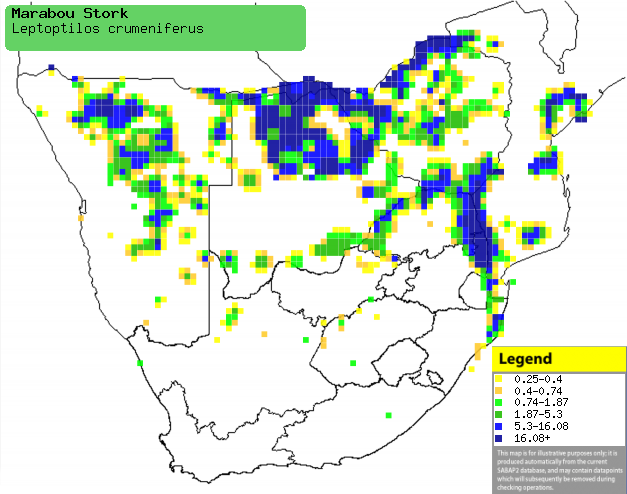|
Leptoptilos crumeniferus (Marabou
stork)
Maraboe [Afrikaans]; Nyumbu [Kwangali]; Mmakaitšimeletša
[North Sotho]; Svorenyama [Shona]; Ghumba [Tsonga]; Afrikaanse maraboe [Dutch];
Marabout d'Afrique [French]; Marabu [German]; Marabu [Portuguese]
Life
> Eukaryotes >
Opisthokonta
> Metazoa (animals) >
Bilateria >
Deuterostomia > Chordata >
Craniata > Vertebrata (vertebrates) > Gnathostomata (jawed
vertebrates) > Teleostomi (teleost fish) > Osteichthyes (bony fish) > Class:
Sarcopterygii (lobe-finned
fish) > Stegocephalia (terrestrial
vertebrates) > Tetrapoda
(four-legged vertebrates) > Reptiliomorpha > Amniota >
Reptilia (reptiles) >
Romeriida > Diapsida > Archosauromorpha > Archosauria >
Dinosauria
(dinosaurs) > Saurischia > Theropoda (bipedal predatory dinosaurs) >
Coelurosauria > Maniraptora >Aves
(birds) > Order: Ciconiiformes > Family: Ciconiidae
Distribution and habitat
Occupies much of sub-Saharan Africa, largely excluding the
lowland forest of West Africa. In southern Africa, it is fairly common to locally abundant in
central and southern Mozambique, Zimbabwe, north-eastern South Africa, northern
Botswana and central and northern Namibia (including the Caprivi Strip). It
generally prefers open semi-arid habitats and wetlands, such as pans, dams and
rivers.
|
 |
|
Distribution of Marabou stork in southern Africa,
based on statistical smoothing of the records from first SA Bird Atlas
Project (©
Animal Demography unit, University of
Cape Town; smoothing by Birgit Erni and Francesca Little). Colours range
from dark blue (most common) through to yellow (least common).
See here for the latest distribution
from the SABAP2. |
Movements and migrations
Resident and nomadic, following patterns of
localised rainfall.
Food
It behaves in a manner similar to vultures, as it is
primarily a scavenger, soaring overhead in search of carcasses. It is also an
opportunistic hunter, catching fish by wading through water and stabbing
them with its bill, hawking termites aerially, hunting birds and raiding their
nests. The following food items have been recorded
in its diet:
- Vertebrates
- carrion
- birds
- mammals
- eggs and young of Nile crocodiles (Crocodylus niloticus)
- Invertebrates
Breeding
- Monogamous, usually breeding in colonies of 10-30, rarely over 100
breeding pairs, often alongside other stork species,
cormorants,
ibises and
herons.
- The nest is built by the female in about 7-10 days with material provided
by the male, consisting of a platform of sticks with a shallow central bowl,
lined with twigs, grass and green leaves. It is typically placed in a tall
Baobab (Adansonia digitata) or a dense thicket of Water figs (Ficus
verruculosa), anywhere from 2-40 metres above ground.
- Egg-laying season is from May-January, peaking from June-September.
- It lays 1-4 eggs, which are incubated by both sexes for roughly 29-31
days.
- The chicks are brooded for the first 10 days or so of their lives then intermittently thereafter, with both parents feeding and brooding them.
They take their first flight at about 95-115 days old, becoming fully
independent roughly 130 days later.
Threats
Not globally threatened, but Near-threatened in
South Africa, due its small population in the country.
References
-
Hockey PAR, Dean WRJ and Ryan PG 2005. Roberts
- Birds of southern Africa, VIIth ed. The Trustees of the John Voelcker
Bird Book Fund, Cape Town.
|
